Foldable Table Leg
KO; Wen-Shan
U.S. patent application number 16/544167 was filed with the patent office on 2020-07-16 for foldable table leg. The applicant listed for this patent is Wen-Shan KO. Invention is credited to Wen-Shan KO.
| Application Number | 20200221862 16/544167 |
| Document ID | / |
| Family ID | 68317475 |
| Filed Date | 2020-07-16 |

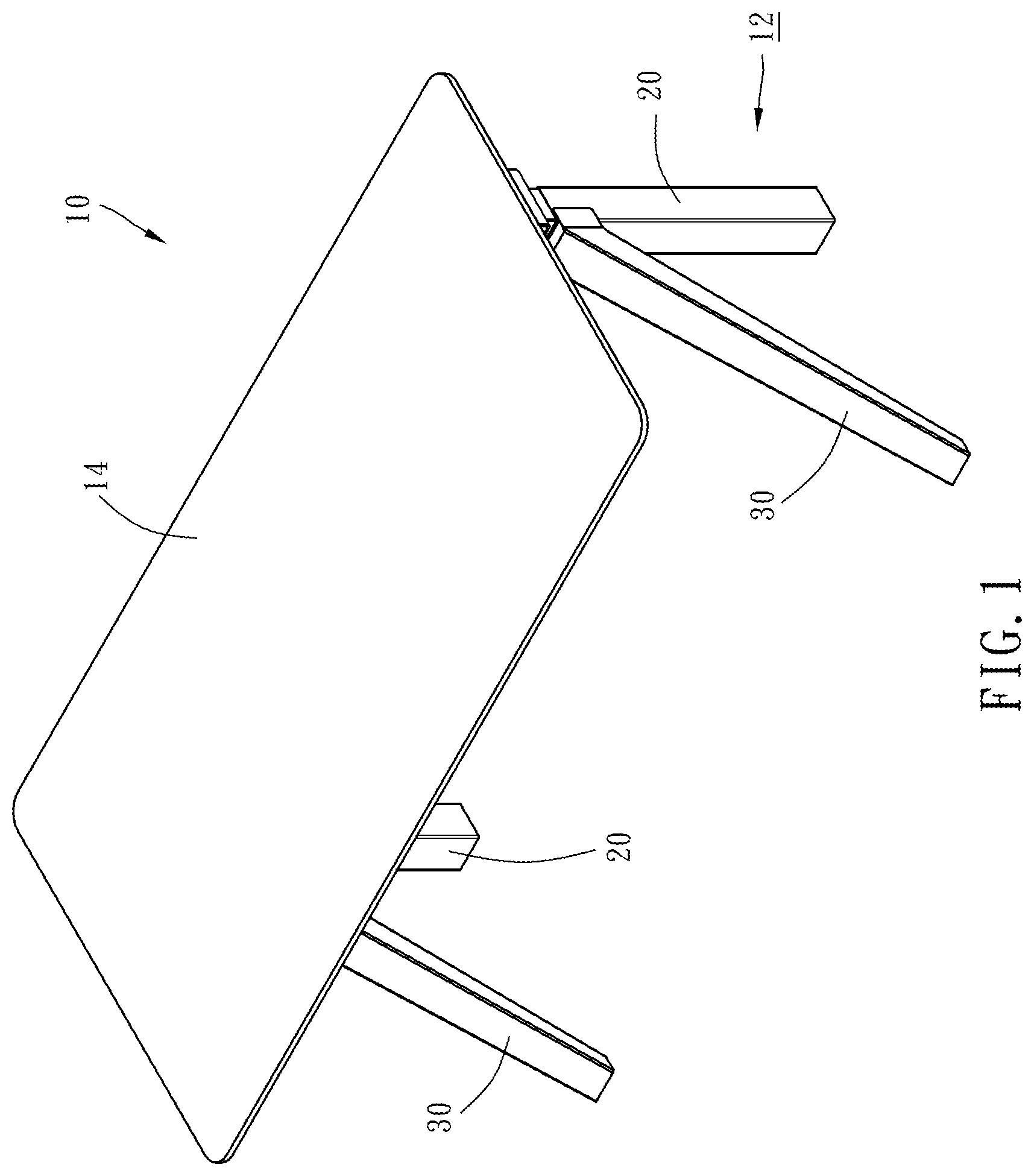
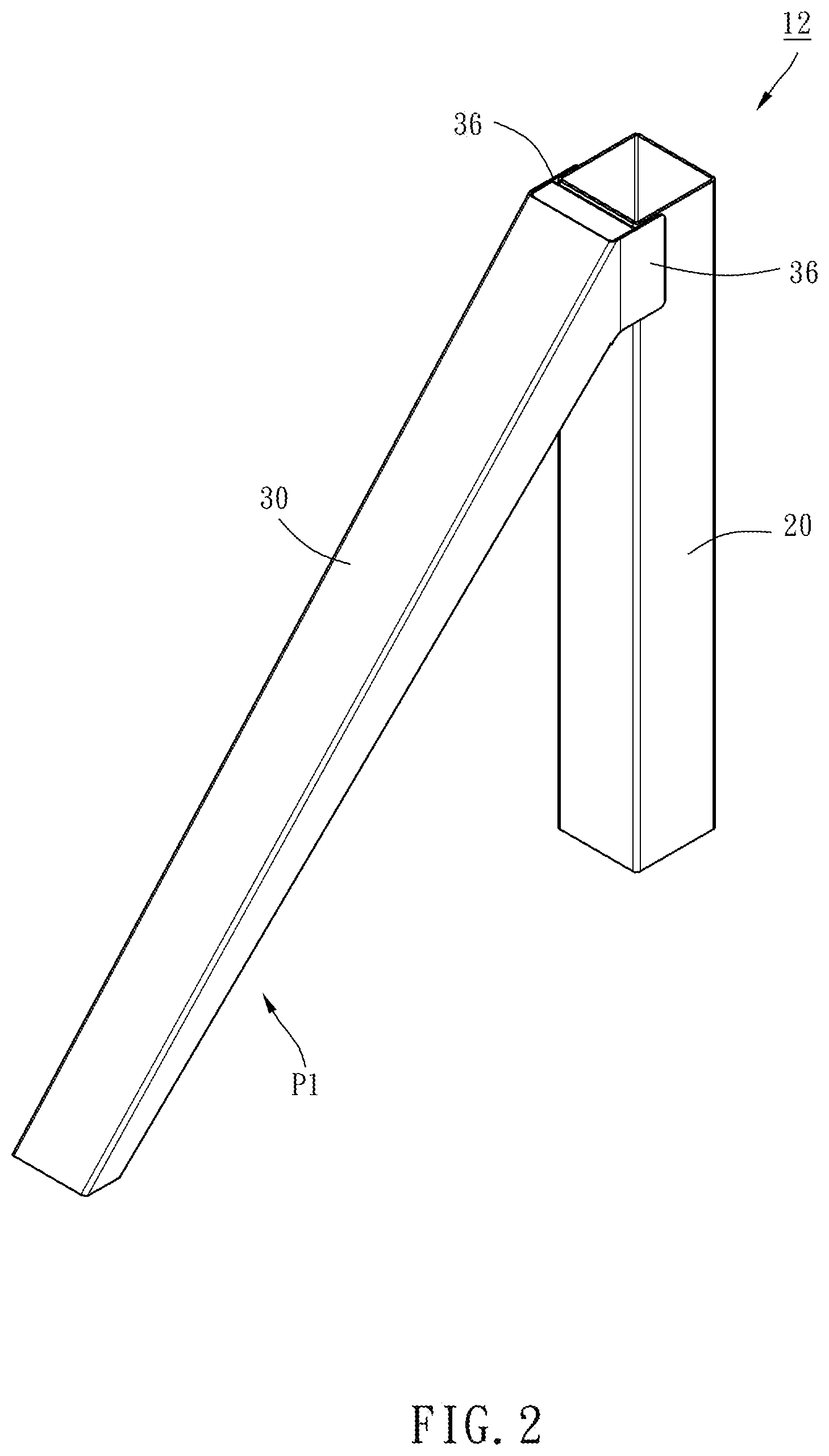


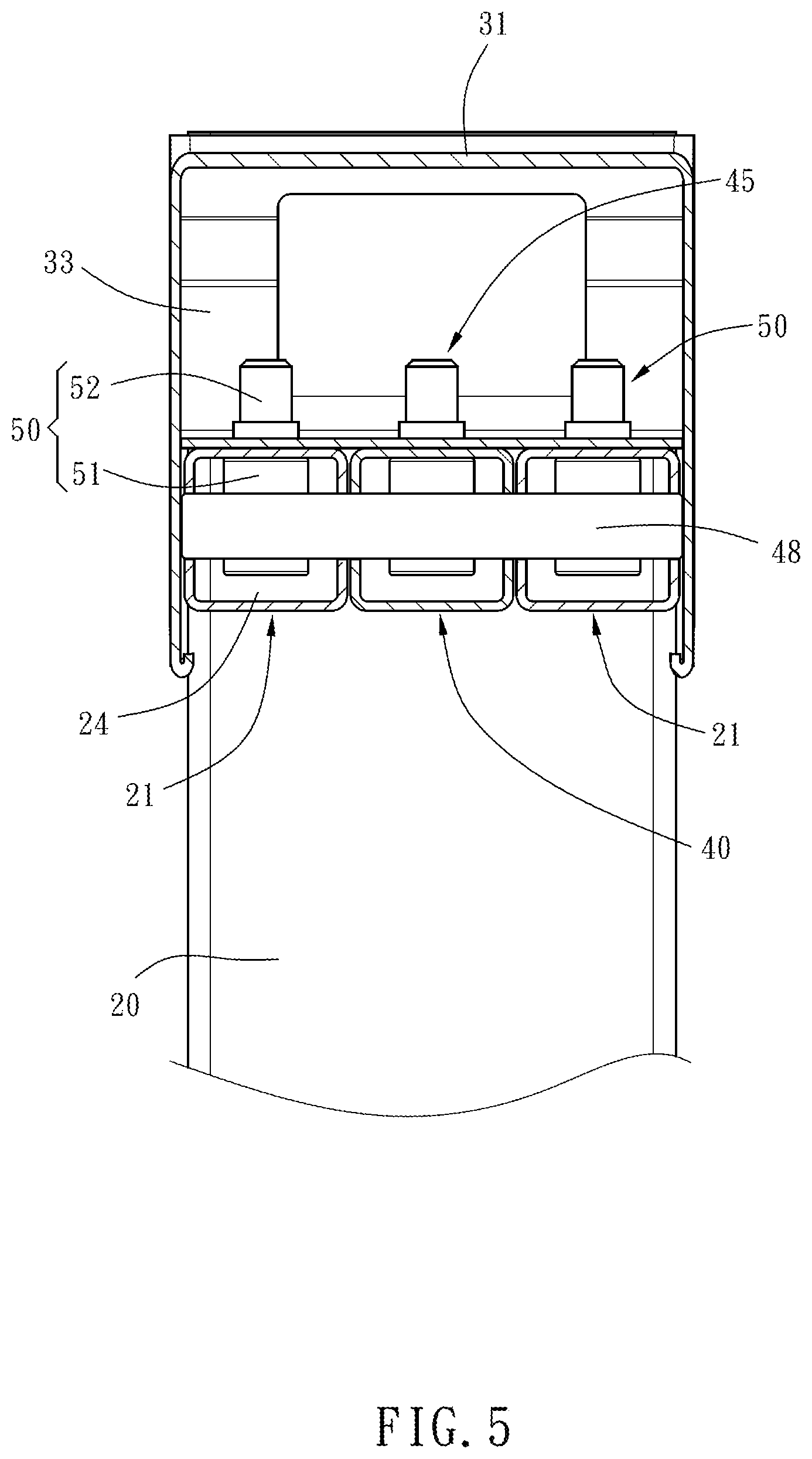
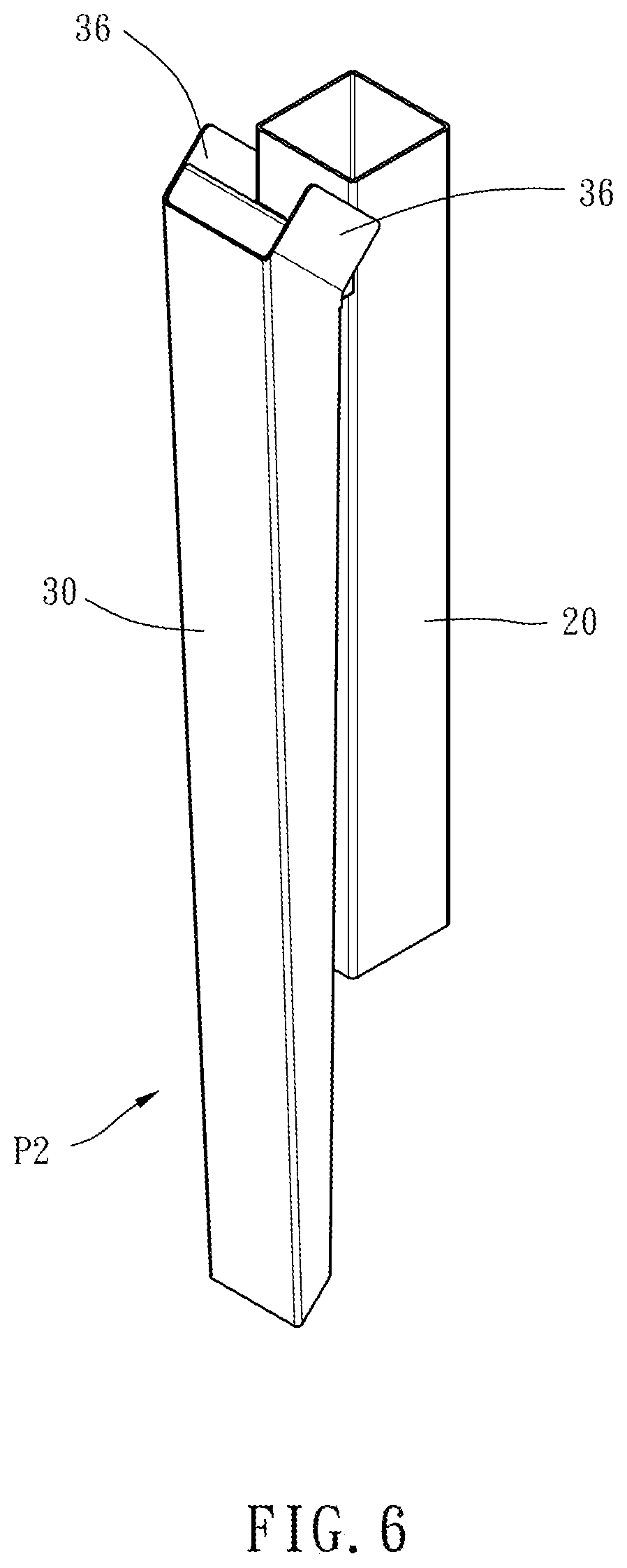
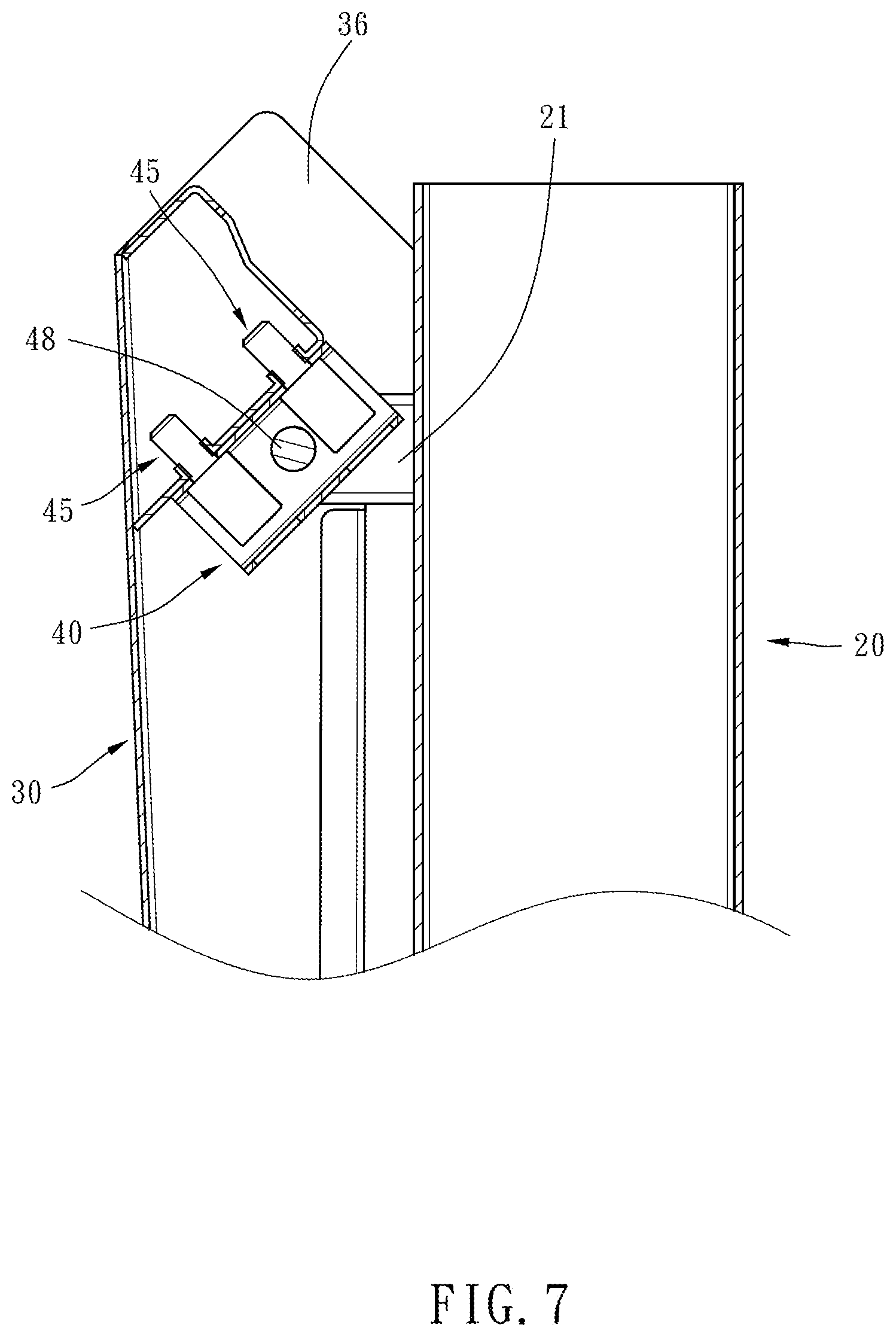
| United States Patent Application | 20200221862 |
| Kind Code | A1 |
| KO; Wen-Shan | July 16, 2020 |
FOLDABLE TABLE LEG
Abstract
A foldable table leg includes a vertical pole, an inclined pole and two positioning members. The vertical pole is provided on the peripheral surface thereof with two protruding lugs facing each other. An end of the inclined pole is pivotably connected to the protruding lugs of the vertical pole in a way that the inclined pole is pivotable relative to the vertical pole between an unfolded position and a folded position. The positioning members fasten the protruding lugs of the vertical pole to an end of the inclined pole in a detachable manner, for positioning the inclined pole at the unfolded position. When the positioning members are detached, the inclined pole is pivotable from the unfolded position to the folded position, so that the objective of reducing the cubic volume and saving space is attained after the inclined pole is folded.
| Inventors: | KO; Wen-Shan; (Lugang Township, TW) | ||||||||||
| Applicant: |
|
||||||||||
|---|---|---|---|---|---|---|---|---|---|---|---|
| Family ID: | 68317475 | ||||||||||
| Appl. No.: | 16/544167 | ||||||||||
| Filed: | August 19, 2019 |
| Current U.S. Class: | 1/1 |
| Current CPC Class: | A47B 3/0911 20130101 |
| International Class: | A47B 3/091 20060101 A47B003/091 |
Foreign Application Data
| Date | Code | Application Number |
|---|---|---|
| Jan 10, 2019 | TW | 108200451 |
Claims
1. A foldable table leg comprising: a vertical pole which is provided on a peripheral surface thereof with two protruding lugs facing each other; an inclined pole having a pivotably connected end which is pivotably connected to the two protruding lugs of the vertical pole in a way that the inclined pole is pivotable relative to the vertical pole between an unfolded position and a folded position; and two positioning members detachably attached to the protruding lugs of the vertical pole respectively and the pivotably connected end of the inclined pole for positioning the inclined pole at the unfolded position.
2. The foldable table leg as claimed in claim 1, wherein each of the protruding lugs of the vertical pole has a first top hole, a first bottom hole coaxially corresponding to the first top hole, and a first accommodating trough communicating with the first top hole and the first bottom hole; the pivotably connected end of the inclined pole has two first threaded holes; each of the positioning members has a head portion and a threaded rod connected with the head portion; the head portion of each of the positioning members is located in the first accommodating trough of one of the protruding lugs; an external radius of the head portion of each of the positioning members is larger than an inner radius of the first top hole and smaller than an inner radius of the first bottom hole; the threaded rod of each of the positioning members is inserted through the first top hole of one of the protruding lugs and screwed into one of the first threaded holes of the pivotably connected end of the inclined pole.
3. The foldable table leg as claimed in claim 2, wherein when the two positioning members are detached, the inclined pole is pivotable between the unfolded position and the folded position.
4. The foldable table leg as claimed in claim 1, wherein when the two positioning members are detached, the inclined pole is pivotable between the unfolded position and the folded position.
5. The foldable table leg as claimed in claim 1, wherein the pivotably connected end of the inclined pole has an inserting trough; the two protruding lugs of the vertical pole are pivotably connected with a connecting block together; the connecting block is inserted in the inserting trough and fastened to the pivotably connected end of the inclined pole.
6. The foldable table leg as claimed in claim 5, wherein the pivotably connected end of the inclined pole has a second threaded hole; the connecting block has a second top hole, a second bottom hole coaxially corresponding to the second top hole, and a second accommodating trough communicating with the second top hole and the second bottom hole; the pivotably connected end of the inclined pole is fastened to the connecting block by a fastener; the fastener has a head portion and a threaded rod connected with the head portion; the head portion of the fastener is located in the second accommodating trough of the connecting block; an external radius of the head portion of the fastener is larger than an inner radius of the second top hole of the connecting block and smaller than an inner radius of the second bottom hole of the connecting block; the threaded rod of the fastener is inserted through the second top hole of the connecting block and screwed into the second threaded hole of the pivotably connected end of the inclined pole.
7. The foldable table leg as claimed in claim 6, wherein the pivotably connected end of the inclined pole is provided on each of two opposite sides thereof with a flank plate; when the inclined pole is located at the unfolded position, the two flank plates are abutted on the peripheral surface of the vertical pole and cover the two protruding lugs.
8. The foldable table leg as claimed in claim 1, wherein the pivotably connected end of the inclined pole is provided on each of two opposite sides thereof with a flank plate; when the inclined pole is located at the unfolded position, the two flank plates are abutted on the peripheral surface of the vertical pole and cover the two protruding lugs.
Description
BACKGROUND OF THE INVENTION
1. Field of the Invention
[0001] The present invention relates to table legs and more particularly, to a foldable table leg.
2. Description of the Related Art
[0002] For the stability of the table, the fixed structure is mainly used in the legs of the ordinary tables. However, the fixed table leg cannot be folded, resulting in too much space occupied in transportation or storage. If it is to be disassembled, the process of the disassembly is bothersome and consumes a long time. When it is to be used again, it needs to be reassembled, so it is quite inconvenient to use.
SUMMARY OF THE INVENTION
[0003] It is a primary objective of the present invention to provide a foldable table leg which can be reduced in cubic volume and save space.
[0004] To attain the above primary objective, the table leg of the present invention includes a vertical pole, an inclined pole and two positioning members. The vertical pole is provided on the peripheral surface thereof with two protruding lugs facing each other. The inclined pole has a pivotably connected end which is pivotably connected to the two protruding lugs of the vertical pole in a way that the inclined pole is pivotable relative to the vertical pole between an unfolded position and a folded position. Each of the positioning members is detachably attached to one of the protruding lugs of the vertical pole and the pivotably connected end of the inclined pole for positioning the inclined pole at the unfolded position.
[0005] Through the above-described configuration design, when the foldable table leg is to be transported, the inclined pole can be folded as long as the two positioning members are detached, so that the effects of reducing cubic volume and saving occupied space are attained. After the foldable table leg is transported in position, the inclined pole can be pivoted to the unfolded position, and then the two positioning members can be screwed on again to position the inclined pole.
[0006] Preferably, the pivotably connected end of the inclined pole is pivotably connected to the two protruding lugs of the vertical pole indirectly through a connecting block.
[0007] Preferably, each of the protruding lugs of the vertical pole has a first top hole, a first bottom hole coaxially corresponding to the first top hole, and a first accommodating trough communicating with the first top hole and the first bottom hole; the pivotably connected end of the inclined pole has two first threaded holes; each of the positioning members has a head portion and a threaded rod connected with the head portion; the head portion of each of the positioning members is located in the first accommodating trough of one of the protruding lugs; the external radius of the head portion of each of the positioning members is larger than the inner radius of the first top hole and smaller than the inner radius of the first bottom hole; the threaded rod of each of the positioning members is inserted through the first top hole of one of the protruding lugs and screwed into one of the first threaded holes of the pivotably connected end of the inclined pole. In this way, when the two positioning members are completely screwed on, they are hided in the protruding lugs respectively, not exposed outside.
[0008] Preferably, the pivotably connected end of the inclined pole is provided on each of two opposite sides thereof with a flank plate; when the inclined pole is located at the unfolded position, the two flank plates are abutted on the peripheral surface of the vertical pole and cover the two protruding lugs, for maintaining the completeness of the appearance of the whole structure.
[0009] Further scope of applicability of the present invention will become apparent from the detailed description given hereinafter. However, it should be understood that the detailed description and specific examples, while indicating preferred embodiments of the invention, are given by way of illustration only, since various changes and modifications within the spirit and scope of the invention will become apparent to those skilled in the art from this detailed description.
BRIEF DESCRIPTION OF THE DRAWINGS
[0010] FIG. 1 is a perspective view of the appearance of a table using table legs of the present invention.
[0011] FIG. 2 is a perspective view of the appearance of the table leg of the present invention, primarily showing an inclined pole is located at an unfolded position.
[0012] FIG. 3 is an exploded perspective view of the table leg of the present invention.
[0013] FIG. 4 is a sectional view of the table leg of the present invention when the inclined pole is located at the unfolded position.
[0014] FIG. 5 is another sectional view of the table leg of the present invention when the inclined pole is located at the unfolded position.
[0015] FIG. 6 is a perspective view of the appearance of the table leg of the present invention, primarily showing the inclined pole is located at a folded position.
[0016] FIG. 7 is a sectional view of the table leg of the present invention when the inclined pole is located at the folded position.
DETAILED DESCRIPTION OF THE INVENTION
[0017] First of all, it is to be mentioned that throughout the specification, including the embodiments described below and the claims, the nouns relating to directionality are based on the directions in the figures. Besides, same reference numerals used in the following preferred embodiments and the appendix drawings designate same or similar elements or the structural features thereof.
[0018] Referring to FIG. 1, the table leg 12 of the present invention is adapted to support a table top 14 on the bottom surface thereof in pairs, so that the table top 14 and a pair of table legs 12 collectively constitute a table 10. Referring to FIGS. 2 and 3, the table leg 12 of the present invention includes a vertical pole 20, an inclined pole 30 and two positioning members 50.
[0019] The cross-section of the vertical pole 20 is rectangular-shaped. The vertical pole 20 is provided on the front side thereof with two protruding lugs 21 facing each other. Each of the protruding lugs 21 has a first top hole 22, a first bottom hole 23 coaxially corresponding to the first top hole 22, a first accommodating trough 24 communicating with the first top hole 22 and the first bottom hole 23, and two first lateral holes 25 communicating with the first accommodating trough 24.
[0020] The top end of the inclined pole 30 is formed as a pivotably connected end 31. The pivotably connected end 31 of the inclined pole 30 has an inserting trough 33, two first threaded holes 34 communicating with the inserting trough 33 and two second threaded holes 35 communicating with the inserting trough 33. The pivotably connected end 31 of the inclined pole 30 is pivotably connected to the two protruding lugs 21 of the vertical pole 20 indirectly through a connecting block 40. The connecting block 40 is inserted in the inserting trough 33 and the connecting block 40 has two second top holes 41, two second bottom holes 42 coaxially corresponding to the second top holes 41, a second accommodating trough 43 communicating with the second top holes 41 and the second bottom holes 42, and two second lateral holes 44 communicating with the second accommodating trough 43. The connecting block 40 is fastened to the pivotably connected end 31 of the inclined pole 30 by two fasteners 45 and pivotably connected between the two protruding lugs 21 of the vertical pole 20 through a pivot 48. Each of the fasteners 45 has a head portion 46 and a threaded rod 47 connected with the head portion 46, as shown in FIGS. 3 and 4. The head portion 46 of each fastener 45 is located in the second accommodating trough 43 of the connecting block 40. The external radius of the head portion 46 of each fastener 45 is larger than the inner radius of the second top hole 41 of the connecting block 40 and smaller than the inner radius of the second bottom hole 42 of the connecting block 40. The threaded rod 47 of each fastener 45 is inserted through the second top hole 41 of the connecting block 40 and screwed into the second threaded hole 35 of the pivotably connected end 31 of the inclined pole 30. The pivot 48 is inserted through the first lateral holes 25 of the two protruding lugs 21 of the vertical pole 20 and the second lateral holes 44 of the connecting block 40, as shown in FIGS. 3 and 5, so that the inclined pole 30 is pivotable relative to the vertical pole 20 between an unfolded position as shown in FIG. 2 and a folded position as shown in FIG. 6.
[0021] The positioning member 50 has a head portion 51 and a threaded rod 52 connected with the head portion 51. The head portion 51 of the positioning member 50 is located in the first accommodating trough 24 of the protruding lug 21. The external radius of the head portion 51 of the positioning member 50 is larger than the inner radius of the first top hole 22 of the protruding lug 21 and smaller than the inner radius of the first bottom hole 23 of the protruding lug 21. The threaded rod 52 of the positioning member 50 is inserted through the first top hole 22 of the protruding lug 21 and screwed into a first threaded hole 34 of the pivotably connected end 31 of the inclined pole 30. In this way, when the two positioning members 50 are screwed on, the inclined pole 30 is positioned at the unfolded position P1; when the two positioning members 50 are detached, the inclined pole 30 is pivotable between the unfolded position P1 and the folded position P2.
[0022] It can be known from the above description that when the table 10 is to be transported, the positioning members 50 are detached by a hand tool, such as a screw driver not shown in the figures, which is inserted into the first accommodating trough 24 of the protruding lug 21 through the first bottom hole 23 of the protruding lug 21. Because the inner radius of the first bottom hole 23 of the protruding lug 21 is larger than the external radius of the head portion 51 of the positioning member 50, the positioning member 50 after being detached can be taken out from the first accommodating trough 24 of the protruding lug 21 to be put at an appropriate location. After that, the inclined pole 30 can be pivoted from the unfolded position P1 as shown in FIG. 2 to the folded position P2 as shown in FIG. 6. After the table 10 is transported in position, the inclined pole 30 can be pivoted from the folded position P2 as shown in FIG. 6 to the unfolded position P1 as shown in FIG. 2, and then the positioning members 50 are screwed on again to position the inclined pole 30 at the unfolded position P1. At this time, the positioning members 50 are hided in the inserting trough 33 of the inclined pole 30 and the accommodating troughs 24 of the protruding lugs 21, not exposed outside. In other words, the table leg 12 of the present invention can be reduced in cubic volume and save occupied space after being folded, that is advantageous to transportion or storage. When it is to be used again, it can be unfolded and positioned as long as the two positioning members 50 are screwed on again.
[0023] On the other hand, the pivotably connected end 31 of the inclined pole 30 is provided on each of the left and right sides thereof with a flank plate 36. When the inclined pole 30 is located at the unfolded position P1 as shown in FIG. 2, the two flank plates 36 are abutted on the left and right sides of the vertical pole 20 and cover the two protruding lugs 21. In this way, the structural stability of the inclined pole 30 after being unfolded is enhanced, and the appearance of the whole table leg 12 is maintained with great completeness.
* * * * *
D00000

D00001

D00002

D00003

D00004

D00005

D00006

D00007

XML
uspto.report is an independent third-party trademark research tool that is not affiliated, endorsed, or sponsored by the United States Patent and Trademark Office (USPTO) or any other governmental organization. The information provided by uspto.report is based on publicly available data at the time of writing and is intended for informational purposes only.
While we strive to provide accurate and up-to-date information, we do not guarantee the accuracy, completeness, reliability, or suitability of the information displayed on this site. The use of this site is at your own risk. Any reliance you place on such information is therefore strictly at your own risk.
All official trademark data, including owner information, should be verified by visiting the official USPTO website at www.uspto.gov. This site is not intended to replace professional legal advice and should not be used as a substitute for consulting with a legal professional who is knowledgeable about trademark law.